- Products
- Solutions
- Service
- Company
Siegenia commissioned MiniTec to realise an assembly and packaging line for the production of a new room fan - including the MiniTec SmartAssist worker assistance system.
Siegenia is committed to indoor comfort and offers solutions for window, door and sliding door systems as well as for ventilation and smart home applications. Decentralised ventilation units are developed and built at the AERO/DRIVE site in Wilnsdorf, Westphalia (near Siegen). The vertical range of manufacture is enormous and, in addition to the construction of the ventilation components, also includes the motorised drives, the production of the circuit boards for the control system and the development of the associated software.
New product as a trigger
The company is highly innovative and is constantly developing its product range. Accordingly, work began in 2022 on the design of a new, extremely compact wall ventilator called AEROPLUS WRG. This was to be launched on the market in spring 2024 and offered via Siegenia's online shop and other platforms. The AEROPLUS WRG enables the simultaneous regulation of supply and extract air in a single solution and has other important performance features such as low inherent noise and high sound insulation. Added to this is the energy-saving recovery of heat during the cooling period using a rotary heat exchanger.
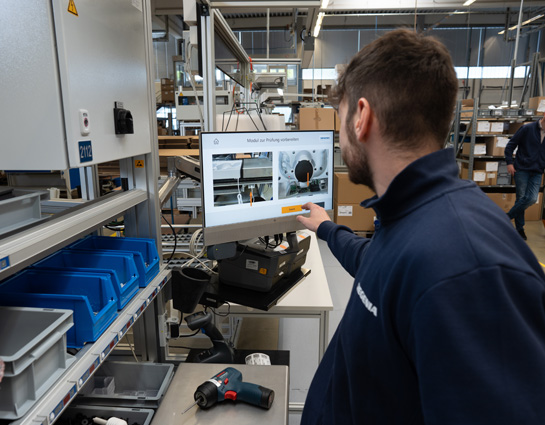
Training time significantly reduced
The training time for new employees has also been reduced with the assistance system, says Groß: ‘Our foreman recently told me that he had never had to train new employees so little. He had only shown them the steps once, and from the second device onwards, the employees were able to build on their own.’ According to Tomm Groß, Siegenia will continue to rely on MiniTec in the future due to the positive experiences, both with regard to the assistance system and workstations in general.
Do you need a suitable solution or an approach for your project? Then please contact us!

The workstations can be designed completely flexibly with the modular system.
The new device consists of three sub-components - a wall module (with the main circuit board), a housing module and a pipe module. The modules are each assembled separately and go into stock separately - to be able to react flexibly when orders come in. Project manager Tomm Groß explains: ‘We also wanted to break new ground in production here.
Because the new fan was to be available in a large number of different equipment versions, we decided not to manufacture it in a one-piece flow, but in separate subcomponents.’ This also has to do with sustainability. This is because there are different weather protection variants, several of which are normally always included in a box.
The ones that are not needed then end up in the rubbish. This should no longer be the case with the new fan. An online configurator is the starting point for every order. The customer defines ‘their’ fan and then only receives the parts they need. Accordingly, production had to be modular and flexible, while at the same time ensuring fast delivery when orders are placed. The three main components were to be manufactured independently of each other, but still had to fit together afterwards.
Customised workstations with worker assistance
When it came to choosing a project partner for the workstations, the decision in favour of MiniTec was quickly made based on positive experiences from the past, according to Groß: ‘We first worked together to design a preliminary concept for the workstations, which led to a development contract to work out the detailed concept. During the concept phase, we also familiarised ourselves with the MiniTec SmartAssist worker assistance system and were immediately impressed by it. We particularly liked the fact that you can create the recipes - i.e. the interactive assembly instructions - yourself using MiniTec SmartEdi.’
Ergonomics important
With regard to the workstations themselves, the decision was made to realise three stations so that the three components could be assembled in parallel. Ergonomics played an important role in the design of the workstations. All desks have electric height adjustment so that employees can set them to the optimum position for them. However, the accessibility of the material was also taken into consideration: ‘We had the challenge of having to accommodate everything from the smallest screw to the relatively large housing within the employee's reach - and in such a way that it works just as well for people 1.60 metres tall as it does for people 1.80 metres tall. MiniTec's experience helped us enormously here,’ says Groß. For the manual workstations, it was clearly possible to create a new standard that has already received a lot of attention and recognition from other areas of the company.
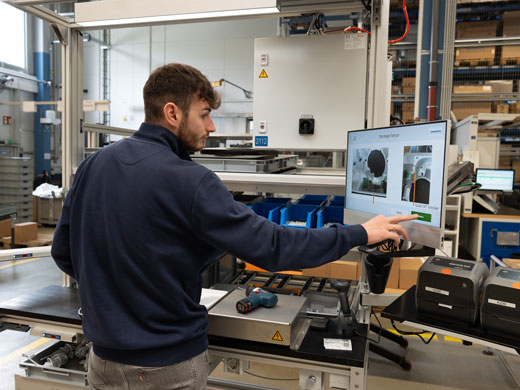
The assistance system guides you step by step through the assembly process.
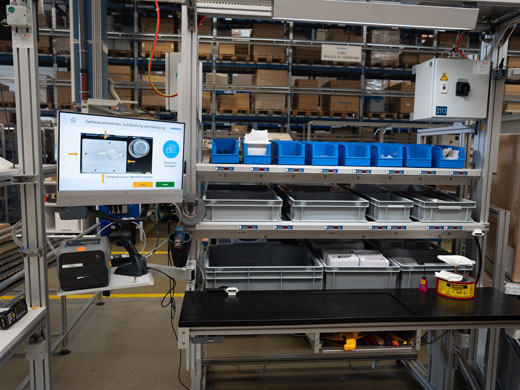
Tidy: everything in its place.
Material provision was converted to Kanban for all small parts and sub-assemblies, which are manufactured in small load carriers: ‘For the large components that we receive on pallets, we have integrated a pallet storage area at each workstation so that the employee can remove the components directly from the pallet and install them. This saves us the time and effort involved in relocating and repacking,’ explains Groß.
Various assistance modules
The MiniTec worker assistance system is used at all three workstations. The interactive guidance of employees through the assembly process is supported in particular by touch monitors and pick-to-light light strips. The latter show the employee from which container he has to remove which part and in what quantity. The screen in turn demonstrates where which part is to be placed and assembled.
The new MiniTec SmartAssist module ‘External Tasks’ is also used, however, in the assembly of the wall component with the integrated main circuit board. There are two versions of the circuit board, ‘Basic’ and ‘Smart’, with correspondingly different software settings. The latest version is always installed on the production date.
Once the employee has installed the motherboard, an external test process is triggered at a specific point in MiniTec SmartAssist - a kind of quality check to ensure that the correct software is on the board, that all connections are correct and that everything is working. If the result is positive, a label is then printed out in multiple copies so that the batch or series from which the product originates can be traced at any time in the event of a problem.
End-to-end digital process The assembly processes at the MiniTec SmartAssist workstations from Siegenia are controlled completely digitally; all three workstations are paperless. The most complex process, due to the integration of external quality inspection, is the wall module.
As with the other modules, the production order is initiated via the MRP. The type plates for the wall module are generated via the production order. These all have a consecutive numerical code as well as a QR code, on which the production order, the serial number and the half-part number are located. There is a PC with a monitor at each assembly station, which runs MiniTec SmartAssist, the EOL software (End of Line) and the IGH production control software. On the latter, all orders for the workstation are displayed on schedule from top to bottom and must be processed accordingly.
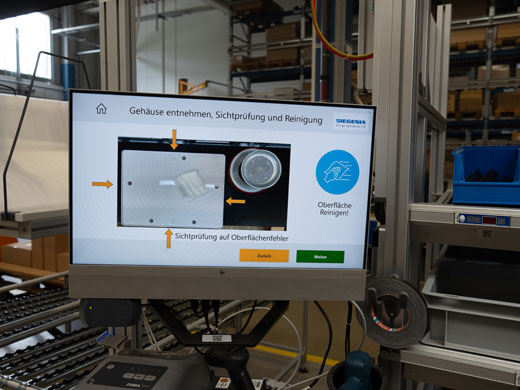
Clear assembly instructions.
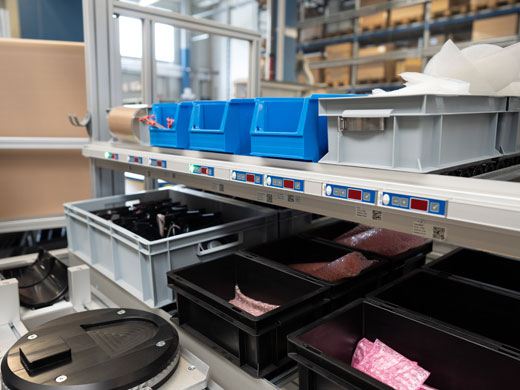
Materials are supplied from the rear using Kanban.
The employee logs on to the order at his terminal via IGH. The nameplate labels are automatically printed out when the employee logs on, which determines the number of appliances to be built. Using the article number from the order, he can now see which recipe needs to be loaded into the assistance system. He selects this on the touch monitor and gets started.
There is a QR code on the type plate labels that shows which software needs to be loaded onto the appliance. The employee uses a handheld scanner to scan the QR code on the rating plate, after which the EOL software starts. Based on the scan, it installs the correct software and decides which tests need to be carried out.
Once the employee has finished installing the wall module, the assistance system prompts him to initiate the inspection process, which he does directly from MiniTec SmartAssist. After carrying out the test, he receives feedback on the test result on the screen. If all tests have been completed correctly, a test label and a dispatch label are printed. At the same time, a test report is stored with the date and all relevant data. This ensures traceability at all times in the event of problems.
Simple maintenance via editor
Groß takes care of creating the instructions with the MiniTec editor himself: ‘I initially created all the recipes at my workplace using CAD data. We then refined and optimised them again and again during practical use.’ And how did he get on with the operation? Very well, says the production specialist: ‘MiniTec has delivered exactly what was promised. It really is relatively easy to implement the recipes in MiniTec SmartEdi.
You can create, store, upload and drag in your own images. You can also quickly create your own layout. This simplicity also continues when adding or repositioning pick-to-light strips. You can unclip them and clip them back in at any position. Within an hour, we had one more Pick To Light module installed.’
High acceptance by employees
The employees are also very impressed by the digital assistance during assembly. After some initial scepticism, they are now happy with the interactive support, says Groß: ‘It makes them more confident and increases their certainty that they are working to a high standard. Of course, we also had a learning process at the beginning, such as how detailed the work instructions have to be. But because we involved the employees in the optimisation process, the system is now very well accepted.’

Once everything is ready, it's time for packing - again supported by MiniTec SmartAssist, of course.
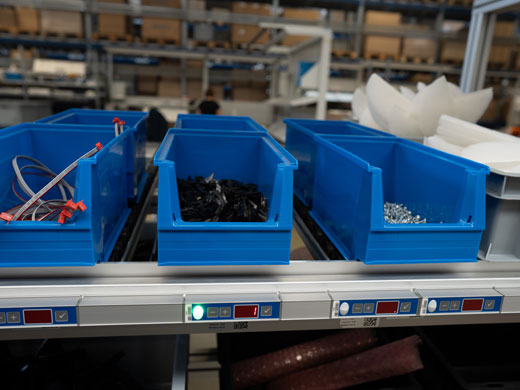
Worker guidance via Pick To Light: Light signals show from which box the next material is to be removed.
Safety during installation also plays an important role for another reason, says Groß: ‘Certain ventilation units run less often than others. In the past, we were faced with the challenge of how an employee could have the routine required for high-quality installation if they hadn't worked on an appliance for several weeks.
Thanks to MiniTec SmartAssist, we now have the advantage that the instructions are directly available and ensure error-free installation.’ But it's not just the assistance system that has been well received by the employees.
According to Groß, the workstations always look neat and tidy from the outside because every part is always where it should be: ‘When the employee is finished, they don't have to put any tools away or tidy up. The workstation is always stocked. All each employee has to do is enter their desired height and they can get started. That's all positive.’
Faster assembly, higher quality
According to Groß, the digitalisation of the processes with the inclusion of MiniTec SmartAssist ensures better cycle times and also higher quality: ‘Previously, the worker had a printed version of the respective work plan, which he rarely consulted during assembly. With MiniTec SmartAssist, he has the necessary steps in front of him at all times. He is therefore much more in the flow and is simply more confident in what he is doing. This makes the quality even better!’